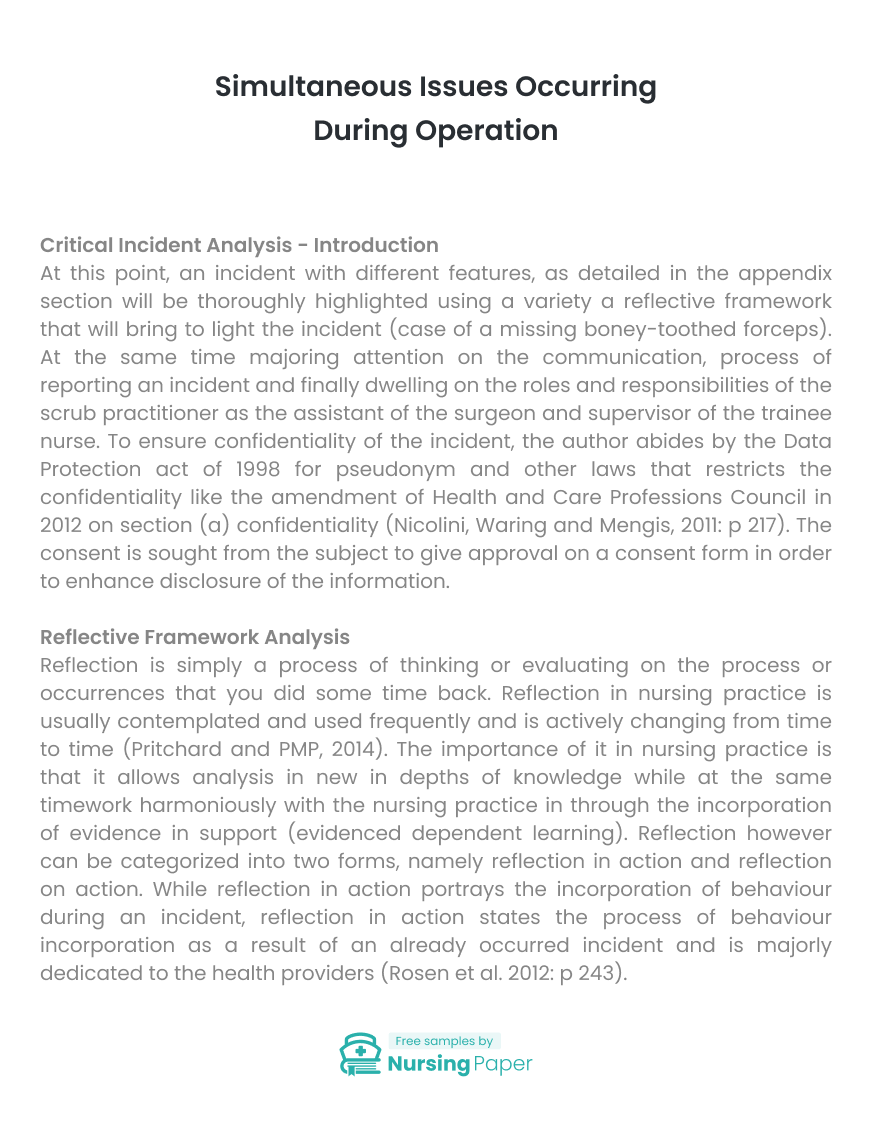1. Atkinson, H.L. and Nixon-Cave, K., 2011. A tool for clinical reasoning and reflection using the international classification of functioning, disability and health (ICF) framework and patient management model. Physical Therapy, 91(3), pp.416-430.
2. Bannigan, K. and Moores, A., 2009. A model of professional thinking: Integrating reflective practice and evidence based practice. Canadian Journal of Occupational Therapy, 76(5), pp.342-350.
3. Bloodworth, K., 2011. The productive ward and the productive operating theatre. Journal of perioperative practice, 21(3), pp.97-103.
4. Clark, P.G., 2009. Reflecting on reflection in interprofessional education: Implications for theory and practice. Journal of Interprofessional Care, 23(3), pp.213-223.
5. Collin, K., Paloniemi, S. and Mecklin, J.P., 2010. Promoting inter‐professional teamwork and learning–the case of a surgical operating theatre. Journal of Education and Work, 23(1), pp.43-63.
6. Crossley, J. and Vivekananda-Schmidt, P., 2009. The development and evaluation of a Professional Self Identity Questionnaire to measure evolving professional self-identity in health and social care students. Medical teacher, 31(12), pp.e603-e607.
7. Davidoff, F., Dixon-Woods, M., Leviton, L. and Michie, S., 2015. Demystifying theory and its use in improvement. BMJ Qual Saf, pp.bmjqs-2014.
8. Gibbs, J.C., Basinger, K.S., Fuller, D. and Fuller, R.L., 2013. Moral maturity: Measuring the development of sociomoral reflection. Routledge.
9. Husebø, S.E., O’Regan, S. and Nestel, D., 2015. Reflective practice and its role in simulation. Clinical Simulation in Nursing, 11(8), pp.368-375.
10. Ilie, G. and Ciocoiu, C.N., 2010. Application of fishbone diagram to determine the risk of an event with multiple causes. Management Research and Practice, 2(1), pp.1-20.
11. Johns, C. and Freshwater, D. eds., 2009. Transforming nursing through reflective practice. John Wiley & Sons.
12. Kelly, M., Morgan, A., Ellis, S., Younger, T., Huntley, J. and Swann, C., 2010. Evidence based public health: a review of the experience of the National Institute of Health and Clinical Excellence (NICE) of developing public health guidance in England. Social science & medicine, 71(6), pp.1056-1062.
13. Kolb, A.Y. and Kolb, D.A., 2012. Experiential learning theory. In Encyclopedia of the Sciences of Learning (pp. 1215-1219). Springer US.
14. Larsson, I.E., Sahlsten, M.J., Segesten, K. and Plos, K.A., 2011. Patients’ perceptions of nurses’ behaviour that influence patient participation in nursing care: a critical incident study. Nursing research and practice, 2011.
15. Mann, K., Gordon, J. and MacLeod, A., 2009. Reflection and reflective practice in health professions education: a systematic review. Advances in health sciences education, 14(4), p.595.
16. Meredith, J.O., Grove, A.L., Walley, P., Young, F. and Macintyre, M.B., 2011. Are we operating effectively? A lean analysis of operating theatre changeovers. Operations Management Research, 4(3-4), p.89.
17. Moon, J.A., 2013. A handbook of reflective and experiential learning: Theory and practice. Routledge.
18. Moon, J.A., 2013. Reflection in learning and professional development: Theory and practice. Routledge.
19. Nicolini, D., Waring, J. and Mengis, J., 2011. Policy and practice in the use of root cause analysis to investigate clinical adverse events: Mind the gap. Social science & medicine, 73(2), pp.217-225.
20. O’mahony, R., Murthy, L., Akunne, A. and Young, J., 2011. Synopsis of the National Institute for Health and Clinical Excellence guideline for prevention of delirium. Annals of internal medicine, 154(11), pp.746-751.
21. Pritchard, C.L. and PMP, P.R., 2014. Risk management: concepts and guidance. CRC Press.
22. Quick, J., 2011. Modern perioperative teamwork: an opportunity for interprofessional learning. Journal of perioperative practice, 21(11), pp.387-390.
23. Robb, M., 2013. Effective classroom teaching methods: A critical incident technique from millennial nursing students’ perspective. International journal of nursing education scholarship, 10(1), pp.301-306.
24. Rosen, M.A., Hunt, E.A., Pronovost, P.J., Federowicz, M.A. and Weaver, S.J., 2012. In situ simulation in continuing education for the health care professions: a systematic review. Journal of Continuing Education in the Health Professions, 32(4), pp.243-254.
25. Serrat, O., 2017. The five whys technique. In Knowledge Solutions (pp. 307-310). Springer, Singapore.
26. Standing, M., 2009. A new critical framework for applying hermeneutic phenomenology. Nurse Researcher (through 2013), 16(4), p.20.
27. Wopereis, I.G., Sloep, P.B. and Poortman, S.H., 2010. Weblogs as instruments for reflection on action in teacher education. Interactive Learning Environments, 18(3), pp.245-261.
28. Yanow, D. and Tsoukas, H., 2009. What is reflection‐in‐action? A phenomenological account. Journal of management studies, 46(8), pp.1339-1364.

The download will start shortly.






 Subject:
Subject:
 Number of pages: 4
Number of pages: 4